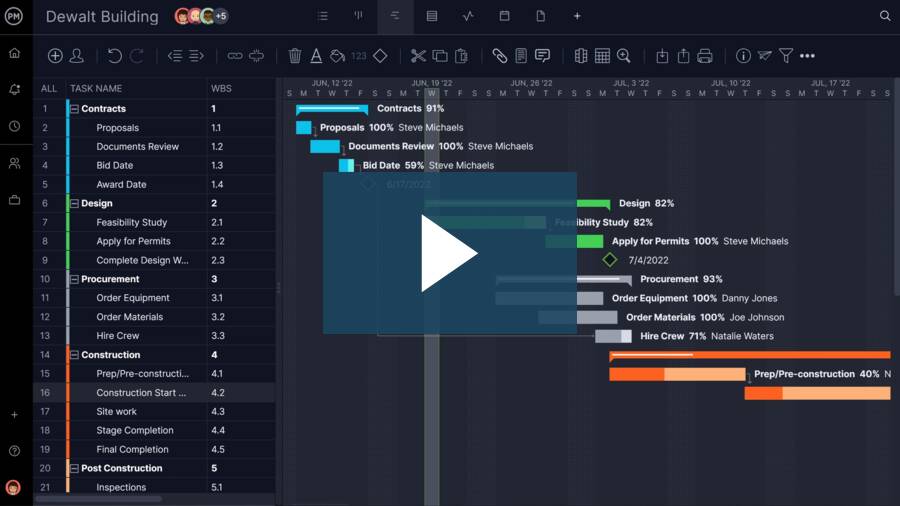Managing a construction project is a complex process that requires careful planning, coordination, and oversight from start to finish. This blog provides a detailed, step-by-step guide to better understand how to manage a construction project.
Whether you’re building a small home or a large commercial facility, understanding the key phases and tasks involved will ensure your project stays on time, within budget, and up to quality standards.
Of all the tools project management software offers, Gantt charts are key. They provide a clear visual timeline of tasks, dependencies and milestones, which is essential for coordinating complex schedules and multiple teams. They help project managers plan each phase of construction, identify critical paths and track progress in real time. By showing when tasks start and finish and how they relate to one another, Gantt charts make it easier to avoid delays, manage resources and keep the project on time and within scope.
That’s why construction firms choose ProjectManager, which has the best Gantt chart. It excels at managing construction and other complex projects by linking all four types of task dependencies to create accurate timelines and prevent scheduling conflicts that can lead to cost overruns. It includes filters to highlight the critical path so managers can focus on tasks with zero slack that directly impact the project deadline.
The Gantt chart also allows users to set a baseline, which makes it easy to compare planned progress against actual results and spot delays early. These features combine to give teams greater control over timelines, resources and budgets throughout the project lifecycle. Get started with ProjectManager today for free.
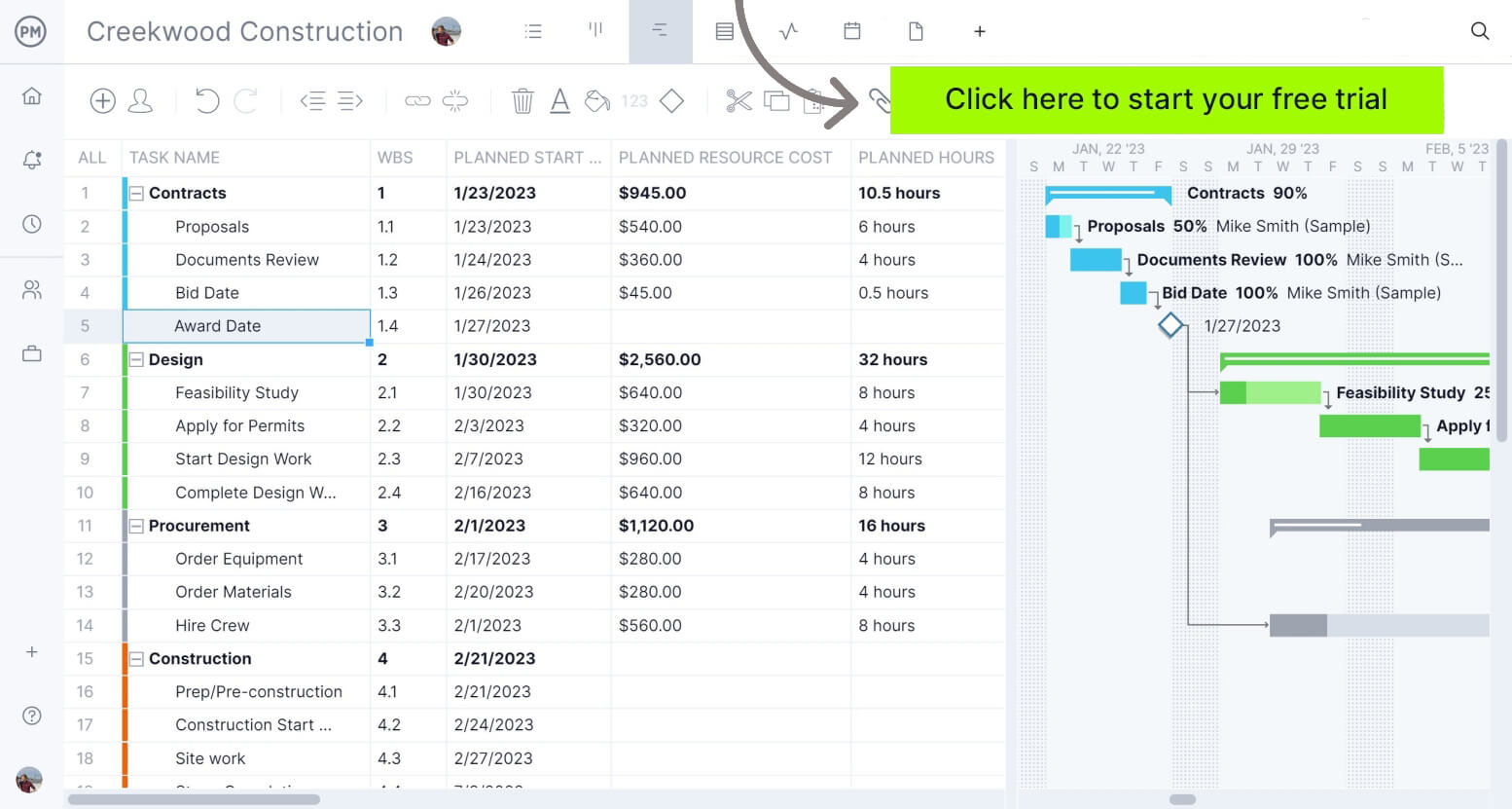
How to Manage a Construction Project Step by Step
Below is a detailed guide on how to manage a construction project step by step, explaining the most important activities and documentation for all construction and project life cycle phases that every construction project goes through.
1. Initiation
The initiation phase marks the beginning of a construction project, where its feasibility, purpose and scope are defined. During this stage, stakeholders assess the project’s value, set clear objectives and secure funding to move forward. This phase lays the foundation for all subsequent work, ensuring everyone involved understands the goals and the resources available. Without proper initiation, a project risks starting without clear direction, which can lead to delays, cost overruns and unsatisfied stakeholders.
Write a Business Case
Writing a business case is crucial because it justifies the need for the construction project. It outlines the problem or opportunity, the proposed solution, estimated costs, expected benefits and potential risks.
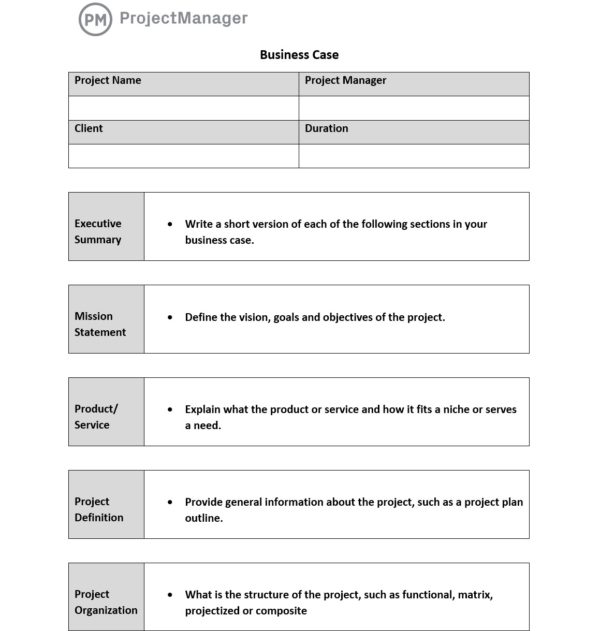
A well-prepared business case helps decision-makers evaluate if the project is viable and worth pursuing. It also serves as a reference point throughout the project, keeping the team focused on the original rationale and ensuring that the outcomes align with the organization’s strategic objectives.
Define the Project Goals and Objectives
Defining clear project goals and objectives provides the direction needed for a successful construction project. Goals state what the project aims to achieve in broad terms, while objectives break these down into specific, measurable actions. This step ensures all stakeholders have a shared understanding of the desired outcome, helping to align efforts and avoid misunderstandings. Goals and objectives serve as benchmarks for measuring progress and determining whether the project is on track.
Perform Risk Assessment and Identify High-Level Risks
Performing a risk assessment and identifying high-level risks early helps prevent problems before they escalate. This step involves analyzing potential challenges—like budget overruns, delays, legal issues, or safety hazards—that could impact the project.
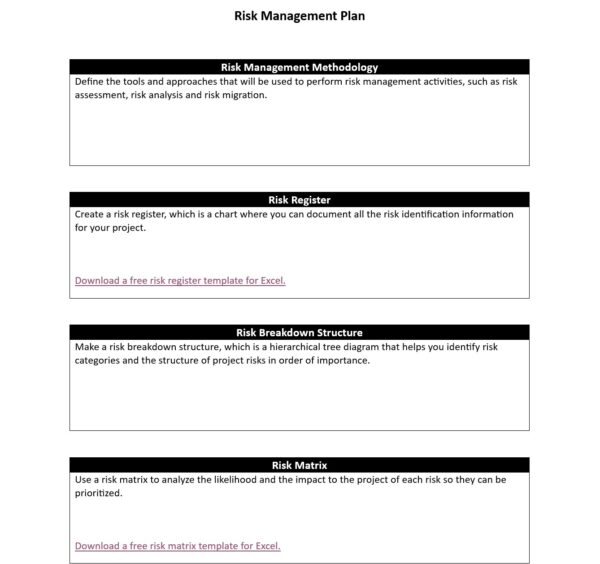
By anticipating risks during the initiation phase, you can develop mitigation strategies and allocate contingency resources accordingly. This proactive approach ensures that stakeholders are aware of possible obstacles and can make informed decisions to keep the project on a stable path.
Conduct a Feasibility Study
Conducting a feasibility study determines whether the project is practical and achievable within the given constraints. This study examines technical, financial and environmental factors to ensure the project can be completed successfully. It assesses whether the site, design and resources align with the project goals and identifies any critical issues that could hinder progress. By validating the project’s viability early, you can avoid committing resources to initiatives that are unlikely to succeed or meet stakeholder expectations.
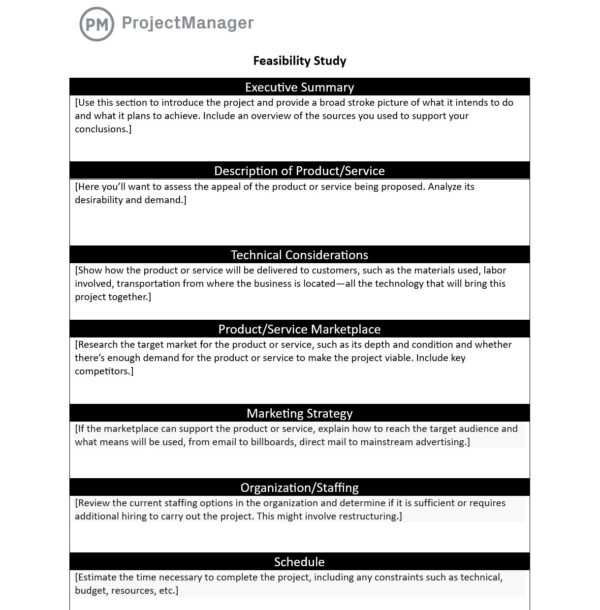
Secure Funding
Securing funding is a vital step that ensures the financial resources are available to complete the project as planned. Without sufficient funding, even the best-planned construction projects can stall or fail. This step involves confirming budgets, obtaining loans or investments and aligning the financing plan with the project schedule and costs. By securing funding during the initiation phase, you provide confidence to stakeholders that the project can move forward and remain financially sustainable through all its phases.
2. Design & Planning
The design and planning phase turns the project’s vision into a detailed roadmap for construction. During this phase, designs are developed, site conditions are assessed, materials and methods are chosen, and schedules and budgets are refined. This stage ensures all requirements are documented and aligned with stakeholder expectations. A well-executed design and planning phase minimizes confusion, reduces risks and lays the foundation for efficient execution, ensuring that the construction phase proceeds smoothly and within agreed parameters.

Write a Scope of Work Statement
Writing a scope of work statement is essential to define exactly what the project will deliver and what activities it includes. It clearly describes the work to be performed, deliverables, timelines and responsibilities of each party.
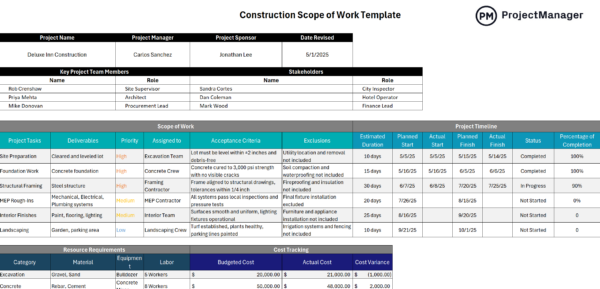
This document serves as a reference for contractors, clients and other stakeholders, helping avoid misunderstandings and disputes. A clear scope of work keeps everyone aligned on expectations, making it easier to measure progress and ensure that the project remains within scope and budget.
Create Drawings and Specifications
Creating detailed drawings and specifications translates the project concept into precise technical instructions. Architectural and engineering drawings define dimensions, materials and construction methods, while specifications outline quality standards and performance requirements. Together, these documents guide contractors on how to build the project and ensure it meets design intent. Accurate drawings and specs minimize errors, reduce change orders and facilitate approvals by clearly communicating expectations to everyone involved in the construction process.
Related: 32 Construction Documents (Templates Included)
Conduct Site Surveys
Conducting site surveys provides critical information about the physical conditions of the construction site. Surveys assess topography, soil conditions, utilities and potential obstacles, ensuring the design is compatible with the site. This step helps identify challenges early, such as unstable soil or drainage issues, allowing the team to adjust plans and avoid costly delays. Accurate site surveys also support compliance with regulations and help contractors plan site preparation activities more effectively.
Obtain Permits and Approvals
Obtaining permits and approvals ensures that the construction project complies with all applicable laws, codes and regulations. This step involves submitting plans and documents to the relevant authorities for review and securing formal permission to proceed. Without the proper permits, construction can be halted, fines imposed or completed work deemed invalid. By handling permits and approvals early in the process, you reduce the risk of legal or regulatory issues, keeping the project on schedule and maintaining credibility with stakeholders.
Conduct a Material Takeoff
Conducting a material takeoff is crucial for accurately estimating the quantity of materials required for construction. This process involves reviewing plans and specifications to list all necessary materials, along with their measurements and quantities. A thorough material takeoff helps prevent shortages, over-ordering, or unexpected costs during construction. It also provides a foundation for budgeting, procurement and scheduling, ensuring that resources are available when needed and contributing to the efficient management of the project.
Prepare a Bill of Quantities
Preparing a bill of quantities (BOQ) provides a detailed, itemized list of materials, labor and other costs associated with the project. This document allows contractors to price their work accurately and provides a basis for comparing bids.
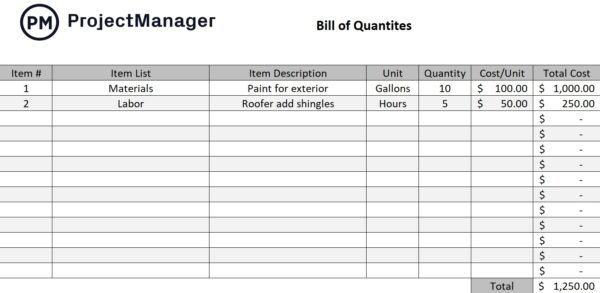
A BOQ promotes transparency by clearly showing what is included in the cost estimates, helping prevent disputes over scope and pricing later. A comprehensive BOQ helps project managers control costs more effectively and make informed decisions throughout the construction process.
Estimate Construction Costs and Make a Budget
Estimating construction costs and creating a budget is critical for ensuring the project is financially viable and controlled. This process involves calculating all expenses, including materials, labor, equipment, permits and contingencies.

A well-prepared budget helps secure funding, guides spending decisions and prevents cost overruns. It also allows project managers to monitor financial performance throughout the project. By accurately estimating and budgeting costs upfront, you set realistic expectations for stakeholders and reduce the likelihood of unpleasant surprises.
Estimate the Duration of Activities and Make a Construction Schedule
Estimating the duration of activities and creating a construction schedule ensures that the project is completed on time and resources are used efficiently. This step involves identifying all tasks, determining their sequence and dependencies and assigning realistic time frames to each. A well-planned schedule helps coordinate teams, manage workloads and track progress against milestones.
Develop a Construction Management Plan
Developing a construction management plan brings together all the essential elements of the project into a single, comprehensive document. This plan outlines how the project will be executed, monitored and controlled, including details on scope, schedule, budget, quality, safety and communication. It serves as a roadmap for the project team and a reference point for stakeholders. A solid management plan enhances coordination, clarifies responsibilities and ensures everyone understands the processes and expectations, contributing to a smoother and more successful project.

3. Pre-Construction
The pre-construction phase bridges the gap between planning and execution by preparing all necessary elements before work begins on site. This stage involves selecting contractors, finalizing agreements, setting up the site, and ensuring everything is ready for construction to proceed smoothly. Effective pre-construction minimizes delays and unexpected problems by addressing logistical, contractual, and safety considerations upfront. By investing time and attention in this phase, project managers can ensure the construction phase starts efficiently and stays on track.
Choose a General Contractor
Choosing a general contractor is a key decision that influences the project’s quality, cost and timeline. The general contractor coordinates all site activities, manages subcontractors and ensures the work complies with plans and standards. This step involves evaluating candidates based on experience, reputation, cost proposals and compatibility with the project team. Selecting the right contractor lays the foundation for a productive partnership, reducing conflicts and increasing the likelihood of a successful project outcome.
Finalize Contracts with Contractors and Subcontractors
Finalizing contracts with contractors and subcontractors formalizes the working relationships and clarifies expectations. These contracts specify the scope of work, payment terms, timelines and legal obligations. Well-drafted agreements protect all parties by defining responsibilities and providing mechanisms to resolve disputes. Taking the time to finalize and review contracts at this stage reduces misunderstandings, ensures compliance with regulations and gives all stakeholders confidence in their roles.
Prepare the Construction Site
Preparing the construction site ensures that work can start safely and efficiently. This step includes clearing debris, grading the land, setting up temporary facilities, establishing access roads and installing utilities. Site preparation also involves marking boundaries and organizing storage areas for materials and equipment. By properly preparing the site, project managers reduce the risk of accidents, improve workflow and avoid delays caused by inadequate or unsafe conditions once construction begins.
Implement Site Security Measures
Implementing site security measures protects workers, equipment, and materials from theft, vandalism, and unauthorized access. Security strategies may include fencing, cameras, lighting, guards, and controlled entry points. A secure site not only safeguards assets but also ensures compliance with insurance and regulatory requirements. By addressing security during the pre-construction phase, you minimize potential losses and disruptions, creating a safer, more controlled environment that supports smooth and continuous operations throughout the project.
4. Procurement
The procurement phase focuses on acquiring the materials, equipment and services necessary to execute the construction project. This phase involves planning, sourcing and managing purchases to ensure the right resources are available at the right time and cost. Effective procurement minimizes delays, controls expenses and maintains quality by working closely with reliable suppliers and vendors. Careful coordination during this stage helps align deliveries with the construction schedule, ensuring smooth progress on the job site without unnecessary interruptions or shortages.
Define a Procurement Schedule
Defining a procurement schedule ensures that materials and equipment arrive when needed, without causing delays or storage issues. This schedule outlines when to order, receive and install each resource, aligning procurement activities with the construction timeline. By planning, project managers can avoid last-minute rushes, mitigate the risk of shortages, and take advantage of favorable pricing or lead times. A clear procurement schedule improves coordination among teams and helps keep the project on time and within budget.
Create a Procurement Management Plan
Creating a procurement management plan formalizes the processes, responsibilities and strategies for acquiring project resources. This document defines how vendors are selected, contracts are managed, risks are handled and deliveries are tracked.
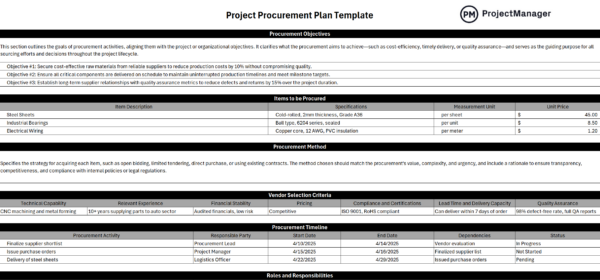
A well-crafted plan promotes transparency and accountability, making it easier to monitor spending, maintain quality, and resolve disputes. By establishing clear procurement procedures upfront, project managers can ensure consistency and efficiency throughout the purchasing process, reducing the potential for costly mistakes or miscommunication.
Select Vendors and Order Materials & Equipment
Selecting vendors and placing orders is a critical step that determines the quality, cost and reliability of the resources used in construction. This involves evaluating suppliers based on criteria such as price, quality, delivery times and past performance. Once vendors are chosen, purchase orders are issued and contracts are signed. Working with trustworthy vendors ensures that materials and equipment meet specifications and are delivered as promised, which helps maintain the project’s momentum and standards.
Plan Material Delivery and Storage Locations
Planning material delivery and storage locations helps maintain an organized, efficient and safe construction site. This step involves scheduling deliveries to minimize congestion and avoid damage, as well as designating secure and accessible areas for storage. Proper planning ensures that materials are readily available when needed, reducing downtime and preventing clutter that can pose safety hazards. By coordinating deliveries and storage thoughtfully, project managers can enhance productivity and maintain control over resources throughout the construction process.
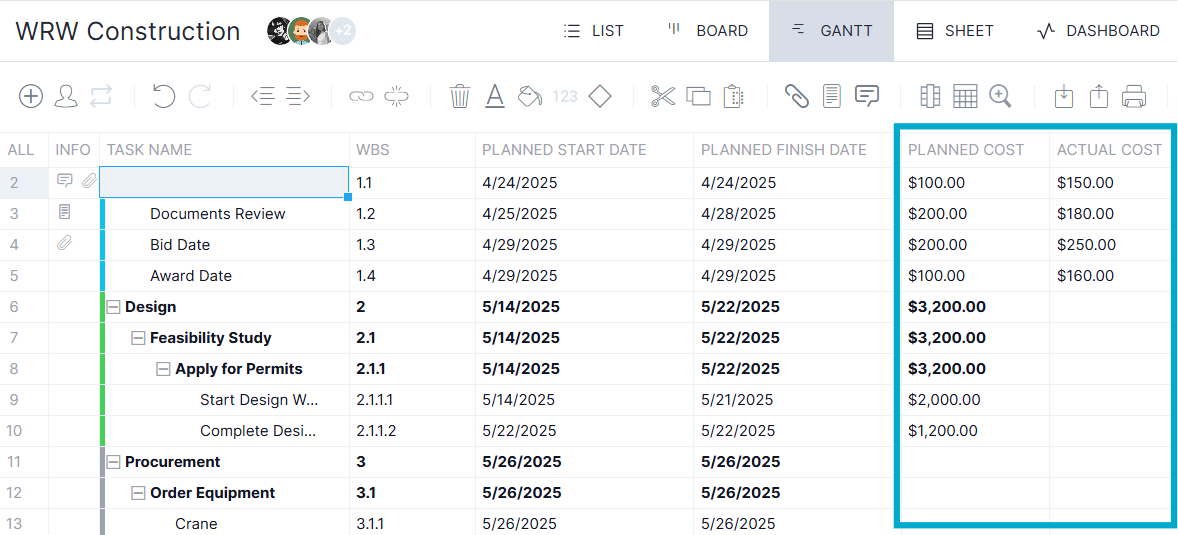
5. Construction
The construction phase is where plans turn into reality as the physical work begins on site. During this stage, crews execute the tasks defined in the schedule, following the drawings, specifications and quality standards. Project managers oversee progress, resolve issues and ensure safety, all while keeping the project aligned with the budget and timeline. Clear communication, vigilant supervision and documentation are crucial throughout this phase to maintain control, avoid costly mistakes and deliver a successful outcome that meets stakeholder expectations.
Mobilize the Workforce and Resources
Mobilizing the workforce and resources prepares the site for active construction by bringing in personnel, equipment and materials. This step involves setting up site offices, positioning equipment and organizing teams to start work efficiently. Proper mobilization ensures that everything is in place and ready to go from day one, avoiding unnecessary delays. It also sets the tone for the rest of the project, as an organized and well-prepared site fosters productivity, safety and smooth coordination among all parties involved.
Monitor the Project Budget and Schedule
Monitoring the project budget and schedule during construction is vital to keeping the project under control. This step involves regularly tracking actual costs against the budget and measuring progress against the timeline. Continuous oversight allows project managers to identify deviations early and take corrective actions before they escalate. Staying on top of these metrics ensures that the project remains financially viable and delivered on time, which maintains stakeholder confidence and protects the project’s overall success.
Maintain Daily Site Logs and Reports
Maintaining daily site logs and reports provides a clear and detailed record of what happens on the job site each day. These logs typically include information about workforce activity, weather conditions, equipment use, inspections, deliveries and any issues encountered.
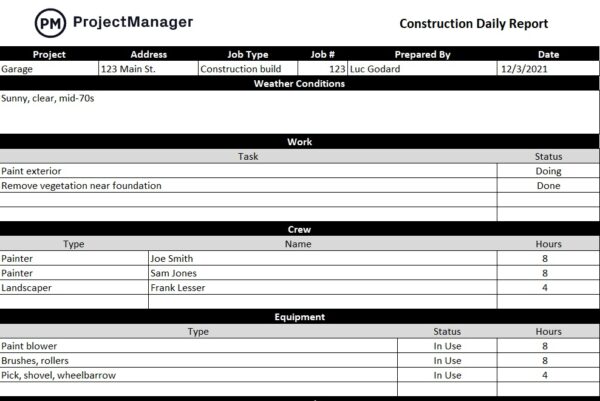
Consistent documentation helps project managers track progress, resolve disputes and support claims if needed. It also promotes transparency and accountability by keeping stakeholders informed and creating a historical record that can guide future projects and decisions.
Ensure Quality Control and Safety Compliance
Ensuring quality control and safety compliance safeguards both the project integrity and the well-being of workers. This step involves inspecting work regularly to verify it meets design specifications and industry standards, as well as enforcing safety protocols to prevent accidents. Maintaining high quality reduces costly rework and strengthens the client’s confidence in the final product. Prioritizing safety also minimizes disruptions, legal issues and injuries, fostering a positive work environment and ensuring the project proceeds without unnecessary setbacks.
Coordinate Site Logistics
Coordinating site logistics keeps the job site organized, efficient and safe. This step involves planning and managing the movement of materials, equipment and personnel to prevent bottlenecks or hazards. Effective logistics ensures that resources are delivered where and when needed, minimizing downtime and waste. It also includes managing site access, storage areas and waste removal.
Supervise On-Site Work
Supervising on-site work ensures that daily activities are executed correctly and according to plan. This involves overseeing crews, checking progress, addressing issues and facilitating communication among team members. Close supervision allows managers to detect and correct problems early, maintain quality standards and keep the project aligned with its schedule and budget.
Related: 18 Best Construction Scheduling Software of 2025
6. Inspection and Handover
The inspection and handover phase ensures the construction project is completed to the agreed standards and formally transferred to the owner. This stage involves thoroughly inspecting the work, resolving outstanding issues, obtaining required certifications and handing over the building along with all necessary documentation. It marks the official end of construction and confirms that the facility is safe, functional and ready for use.
Conduct Final Inspections and Complete Punch List
Conducting final inspections and completing the punch list verifies that all work meets design specifications, codes and quality standards. The punch list documents any deficiencies, such as minor repairs or incomplete tasks, that must be addressed before project completion. Resolving these items ensures the building is fully functional and free of defects. This step protects both the owner and contractor by confirming that contractual obligations have been fulfilled.
Related: Free Punch List Template
Obtain Occupancy Permit and Other Certifications
Obtaining an occupancy permit and other necessary certifications confirms that the building complies with all legal, safety, and regulatory requirements. This step involves final inspections by local authorities and approval of the completed construction. Without these permits, the building cannot legally be occupied or used. Securing these certifications demonstrates that the project has been executed responsibly and to code, giving stakeholders confidence in the safety and quality of the finished facility while avoiding potential legal or operational issues.
Handover Documentation and Keys to Owner
Handing over documentation and keys formally transfers responsibility for the building to the owner. This includes providing as-built drawings, warranties, maintenance manuals and any relevant certificates. These documents help the owner understand the building’s systems and how to maintain them properly. Delivering a complete and organized handover package demonstrates professionalism and ensures the owner has everything needed to operate the facility effectively. This step closes the project on a positive note, leaving a lasting impression of quality and reliability.
7. Post-Construction
The post-construction phase ensures the project is fully closed out and all outstanding responsibilities are addressed after handover. This stage includes resolving warranty claims, completing financial and contractual obligations and evaluating project performance. It provides an opportunity to support the owner, assess what went well and identify areas for improvement. A thorough post-construction process strengthens relationships with stakeholders, helps prevent future issues and provides valuable insights that can improve the management of future projects.
Resolve Warranty Issues and Defects
Resolving warranty issues and defects ensures the owner receives a fully functional building that meets expectations even after handover. During this period, contractors address any problems that arise, such as faulty systems or construction flaws, at no additional cost to the owner. This step builds trust and reinforces accountability, showing commitment to quality. Addressing these issues promptly minimizes disruptions for the owner and protects the contractor’s reputation, contributing to long-term client satisfaction.
Close Contracts and Finalize Payments
Closing contracts and finalizing payments brings closure to the financial and legal aspects of the project. This involves ensuring all invoices are paid, liens are released and contractual obligations are fulfilled. Properly closing out contracts prevents disputes, maintains good relationships with vendors and subcontractors and provides a clean financial record. This step also frees up resources for future projects and ensures compliance with all legal and financial requirements, completing the project responsibly and professionally.
Conduct a Post-Project Review and Document Lessons Learned
Conducting a post-project review and documenting lessons learned helps improve future construction projects. This step involves gathering feedback from stakeholders, analyzing performance against goals and identifying successes and challenges. By reflecting on what worked well and what could be improved, teams can develop best practices and avoid repeating mistakes. Documenting these insights contributes to organizational learning, enhances efficiency and strengthens project management capabilities over time.
How to Manage a Construction Project Step by Step With ProjectManager
ProjectManager manages construction projects by combining powerful planning, tracking and resource management tools to keep teams aligned and work on schedule. Its resource management features include availability settings that ensure tasks are scheduled based on each crew member’s actual work hours and time off.
The color-coded workload chart provides a visual overview of task distribution so managers can easily spot over- or underutilized resources and adjust workloads to maintain efficiency. The team page brings all this data together, showing roles, assignments and capacity at a glance, which helps coordinate trades crews and subcontractors across phases of construction with greater precision and control.
Learn more about how our construction project management software can help manage construction projects.
Use Multiple Construction Project Management Views
Multiple project views help manage construction projects by giving teams flexible ways to plan and track work based on their specific roles and needs. The Gantt chart maps out timelines, dependencies and milestones to manage complex phases and schedules. The kanban board helps field teams visualize progress and manage tasks through workflow stages.
The calendar view organizes tasks by date to keep crews on track and avoid delays. The sheet view gives a spreadsheet-like format for those who prefer to sort and analyze data. The list view is ideal for construction crews and subcontractors by breaking down tasks into a clean, actionable format that’s easy to update, sort and filter, making it ideal for daily coordination and site-level task management.

Track Project Metrics on Dashboards, Reports and Timesheets
Use real-time project and portfolio dashboards, customizable reports and secure timesheets to help track project metrics and improve performance. Dashboards provide instant visibility into key data like progress, cost and resource allocation across one or multiple projects so managers can make informed decisions quickly.
Customizable reports allow teams to dig deeper into specific metrics such as task completion, budget variance or team performance to identify trends and address issues early. Secure timesheets track actual hours worked, helping control labor costs, verify time entries and maintain accountability. Together, these tools support accurate tracking and better management of any project or portfolio.
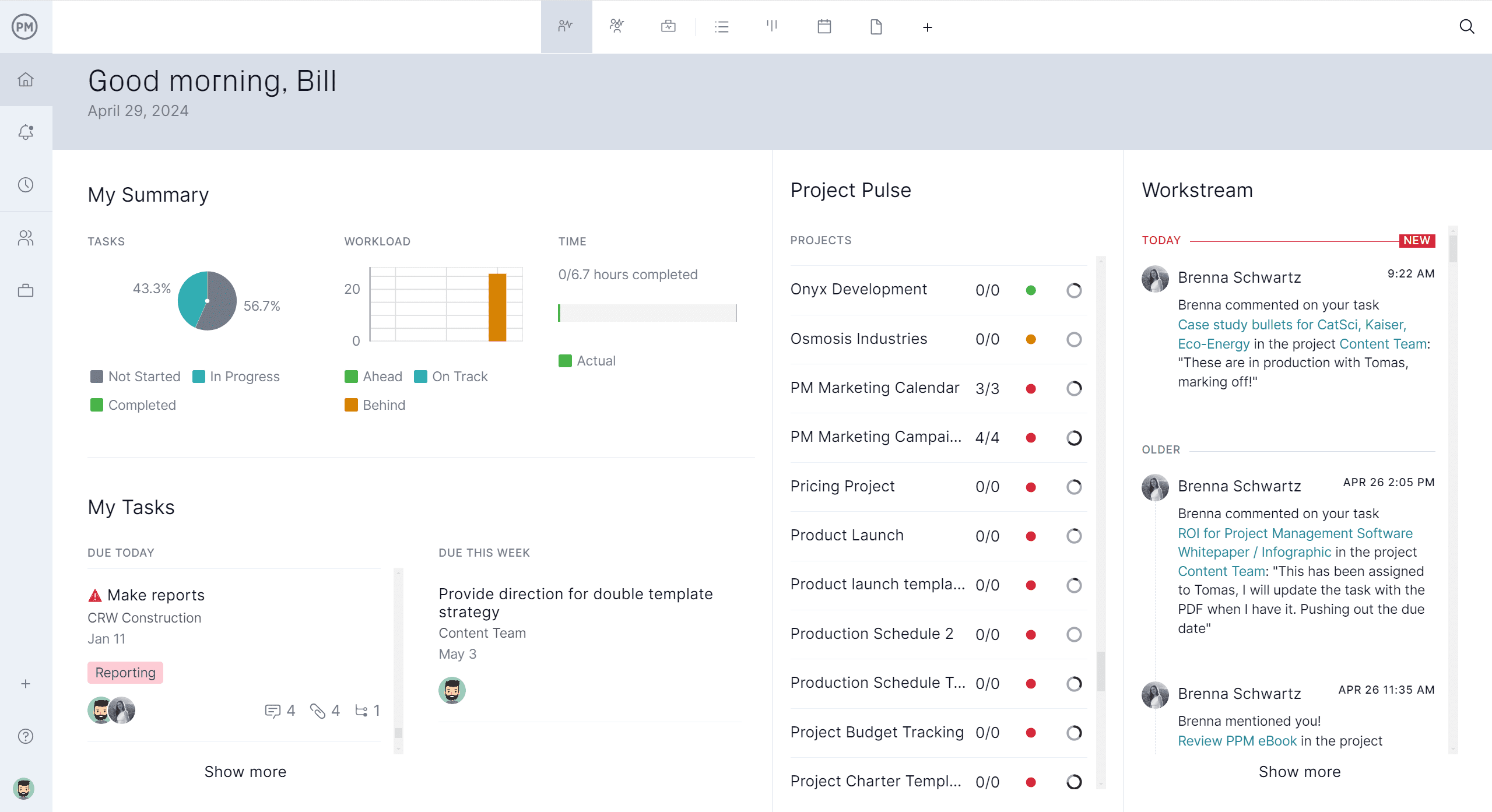
Related Construction Project Management Content
After learning how to manage a construction project step by step, you’re going to want to focus on the different types of construction projects, construction documents, methods and techniques. Those topics and many more can be found in the links below.
- 18 Best Construction Scheduling Software of 2025
- 10 Types of Construction Projects with Examples
- 18 Construction Methods and Techniques
- 10 Construction Project Delivery Methods with Pros & Cons
- 32 Construction Documents (Templates Included)
- 14 Types of Construction Contracts: Pros, Cons & Best Practices
- Critical Path Method (CPM) in Construction: A Quick Guide
ProjectManager is online project and portfolio management software that connects teams whether they’re in the office or on the job site. They can share files, comment at the task level and stay updated with email and in-app notifications. Join teams at Avis, Nestle and Siemens who are using our software to deliver successful projects. Get started with ProjectManager today for free.

